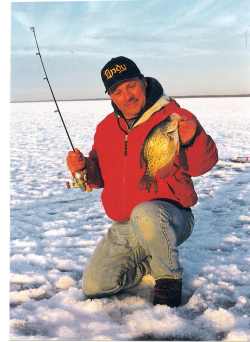
|
||||||||
|
Promotional Team Favorites Lodging food and more 
Free 90 day Risk free trial offer click here 
|
By JOHN KOLINSKI
Editor's note: John Kolinski is an eight-time championship qualifier during his seven years of professional fishing on the Professional Walleye Trail and Masters Walleye Circuit. His articles can be read in a number of publications and at top walleye-fishing sites on-line. For many angling enthusiasts, March Madness is a time between the ice-fishing and open-water seasons when the call of the wild simply isn't as strong as it was back in December and cabin fever gets a firm grip. There's not some magical change that suddenly turns fish into prodigious pigs as the hard-water season winds down, but there are still plenty of fish to be caught for those willing to put in the time and effort. Location becomes more predictable as most species begin moving toward traditional spawning grounds. Pike will likely be migrating into positions near shallow, marshy backwater areas where they'll spawn. Walleyes in systems fed by a river will begin working toward moving water. In lake and reservoir environments without river influence, they'll be sliding into deep water around traditional spawning reefs or hard-bottomed humps. Crappies can often be found suspended over deeper water near the shallow bays where they'll move when the ice goes out. Sometimes, they'll be tight to the bottom, too, so a good sonar unit is a must. Bluegills and sunfish usually take up residence in the decayed weed growth from the open-water season where food is plentiful. Perch tend to move from deep-water structure into shallower bays. I've also found that it's a good time to explore smaller lakes. In general, they'll maintain safe ice a little longer than big lakes, but they also offer a population of fish that don't get beat up in the summertime because of extensive weed growth. No matter where you find these late-season fish, finesse is still the key to making them bite. By March, we're working on educated fish that have been able to avoid making a mistake that would land them in a frying pan.
be better than it is in the winter when it's not subject to wind and weather. I like flashy baits, as well, and have become a big fan of glow-style lures. It's amazing how quickly you can attract a crowd of bluegills when you drop a bait down the hole. They obviously see well. It follows that we'll catch more fish by putting a high-visability bait down there.
are far livelier and more colorful.
two rods are legal, I often set up one with a hook and minnow or a micro-jig and wiggler and leave it alone.The final late-ice method that's coaxed a lot of fish into biting for me is an ever-so-slight wiggle of the lure. When I know there's a fish staring my bait down but it won't bite, a little twitch often does the trick. So don't give up on the ice-fishing quite yet. There are still plenty of fish to be caught while your friends and neighbors are watching fishing shows on television and waiting for the open-water season. Just be careful. Avoid lakes where the ice is breaking away from shore. Always carry a life preserver and 100 feet of rope. And if you have any doubts, stay off. It's hard to catch any fish from the hospital or cemetery. E-mail John Kolinski Fish Clix Banner Exchange Please visit these site sponsors |
|||||||
|---|---|---|---|---|---|---|---|---|



